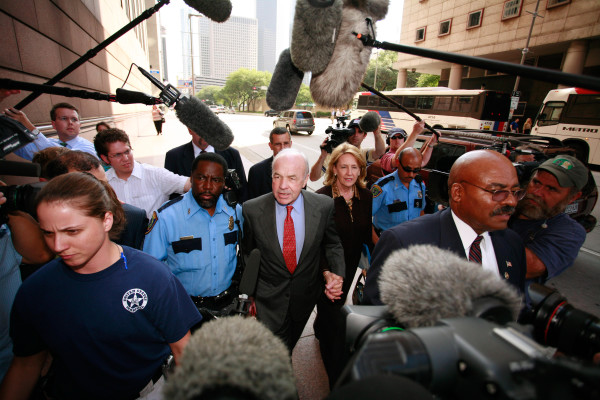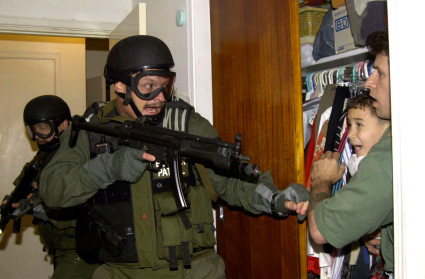INTERVIEW: Nat Geo looks back at Enron, Elián, iPhones, ‘Survivor’ on new ‘2000s’ doc

It’s one for the history books.
National Geographic Channel is set to premiere its expansive look at the first decade of the new millennium with the airing of The 2000s: A New Reality, which will be broadcast 9 p.m. July 12 and 13. Charting the many news stories of those memorable 10 years, from 9/11 to the inauguration of President Barack Obama, the program offers a unique look at the not-too-distant past.
For Sherron Watkins, former vice president of Enron and infamous whistleblower, the 10 years that are profiled are not necessarily the happiest of memories. “It was a pretty bleak decade really,” she said recently during a phone interview.
Enron is a company name that now stands for corporate greed. When the towering giant began its precipitous fall at the end of 2001 and beginning of 2002, a new wave of self-doubt spread throughout the business world. Watkins played a key role in the unraveling. She switched positions in the company in the summer of 2001 and found evidence of “fraud that masked $500 million in losses in the year 2000.”
At the time, Watkins warned CEO Ken Lay of the pending implosion. “When a company cooks the books their best bet is to come clean themselves,” she said. “I was trying to give him that heads-up, but I was really very naïve and almost stupid. I still was asking him to fall on his sword.”
The story of Enron continues to fascinate and likely disgust everyday Americans.
“Sometimes I think there’s interest because there’s a sense nationwide and even worldwide that the root causes haven’t been fixed,” Watkins said of Enron’s enduring legacy. “That feeling was sort of vindicated or justified with the 2008 Wall Street collapses, which were even bigger than Enron’s. So I still think there’s that sense of what happened, why, what are the causes, how can I protect myself.”

Watkins, who was a Time person of the year in 2002, said she doesn’t like the whistleblower label because it’s “very toxic,” reminding people of a tattletale. At the time, she tried to get Enron’s management to make the right decisions, but the wounds were too deep. In the wake of the Enron scandal, Washington, D.C., has passed legislation to protect whistleblowers.
“Why are there so many whistleblowers?” Watkins asked. “What’s happened to the checks and balances system? Why do people need to come forward in a whistleblower fashion to correct wrongs?”
With more than a decade of perspective on the entire affair, Watkins looks back and sees the scandal as an example of “stock options run amok.”
“Enron really began to use stock options in earnest the last half of the 1990s, and it puts everyone from the top to the bottom focused on the wrong thing, the stock price,” she said. “And it makes everyone want to put blinders on and not see that the emperor is wearing no clothes because it’s not just that the emperor is going to be embarrassed. It’s the fact that, wow, this could impact our stock price, and I was sure hoping to sell stock options and buy a new house or buy a new car. And it makes everyone want to swing for the fences, protect the stock price, hide the truth.”
Watkins admitted that she has lost friendships because of her coming forward to tell Enron’s truths. “When they see me walking down the street or walking into the grocery store or running into places, there’s this uncomfortable feeling, and I’ve seen people try their hardest to make sure we don’t make eye contact at a restaurant,” she said. “So some of that is disheartening because your relationships are just not the same.”
Of course, Enron is not entirely unique. The financial crisis of 2008 was yet another example of corporate greed, and Watkins sees parallels. “I have a feeling that until we fix the stock-option issue you’ve got pressures inside an organization that are just at opposition,” she said. “I mean I am all for the capitalist system. … But it has to be moral. It has to have high integrity, and people always think they’re doing the right thing but they guise things like I said in terms of stock prices or shareholder value. … Instead of talking about what we’re doing for customers you’re talking about the stock price and your stock options that are under water. So that really makes people hide from the truth.”
Here’s what Watkins believes about CEO incentives and shifting the business culture to a more ethical foundation: “I’m not really for a lot of regulation, but I am for looking at the stock-options incentives and how it incentivizes short-term behavior because if I can manipulate financial statements and make everything look rosy for two or three years, I can go home a multibillionaire, at least enough millions that my great-grandchildren will be fine. … We can’t have that disconnect where CEOs drive a company over the cliff, and they were able to get a parachute or jump out right before it goes over the cliff. Those incentives are just not aligned properly, and I think that’s why I’m still in demand, going around giving speeches and hearing about it. Part of it it’s now in the history books, so when you talk to college kids, they’ve studied Enron. It’s a case study.”

In addition to profiling such events as the 9/11 terrorist attacks and the capture of Saddam Hussein, The 2000s looks at one of the most divisive news stories of the decade: the Elián González saga.
Donato Dalrymple, one of the fishermen who found Gonzalez floating in the ocean, was interviewed for the program. Here’s how the newsmaker remembers the beginning of that story.
“It was back in December of 1999,” Dalrymple said. “Two cousins, we haven’t been together in a while, both working hard. We went out on the water, got some gas in the boat, and we headed out to the inlet. The story goes like this: My cousin was telling me to look for seaweed and debris, anything floating on the ocean surface. … I’m behind the wheel of the boat, and he’s baiting the poles in the back. We have the radio on with these oldies music. There was really dark, dark skies, and it was kind of weird that morning. And then the sun was rising in the back. It had been a rainy week all week, and there was like a rainbow out there. It was kind of just like an interesting, odd morning. We weren’t going to go, and then we went. We’re cutting across all these rough waters, and I’m looking for seaweed and debris. And then all of a sudden about 3 miles off the coast, I see an inner tube.”
Dalrymple said the two cousins approached the inner tube, getting as close as “25 yards.” They thought there was a doll or “dead person” on the tube, but seeing no signs of life, they continued fishing.
“So we left, went fishing maybe 15-20 minutes away from there,” he continued. “It was just Godsent that we got back in that area and ran into the inner tube again. This time, while we’re about the inner tube, no more than 20-25 yards, all three of the poles that we had on the boat, they started pulling. Zzzzing. … I grabbed my pole, and he [my cousin] grabbed the other two poles. And he pulled in a couple of fish, and I lost mine. And as he’s pulling in the fish, I’m looking over at the inner tube again. I’m saying, ‘There’s a person on there. We got to call for help, right?’ … And then all of a sudden I noticed a hand slip off that inner tube, and it was at that moment that I screamed at my cousin, ‘I’ve seen the hand movement. I’ve seen the hand movement.’”
So began a story that glued the nation to its television sets for months. That boy on the inner tube was González, the survivor of a doomed journey from Cuba to the United States. The fate of the boy was debated in communities across the United States: Should he stay in the U.S. or go back to Cuba with his father?
“We were heading into the inlet after we met the Coast Guard, about a mile off-shore, and we handed him over,” Dalrymple said. “And they said that we could follow them to the shore, and then they were going to take him to the hospital. So, of course, we were curious what was going to happen to him. So when we were going closer to the shoreline there to dock the boat, we looked above and said, ‘Oh, wow, this is bigger than what we thought.’ I mean there were like seven helicopters up there, news stations and everybody was telecasting this. So we didn’t know what it was going to be in the future, but it was a big story at that moment.”
Dalrymple not only helped find the boy in the ocean, but he was also at the place of residence when González was finally handed over to armed officials and taken back to Cuba. The iconic photograph of Darymple holding González in a closet while an assault weapon is raised is one of the most indelible images of the 2000s.
Dalrymple traveled to the house where González was staying that night. He talked to a few of the “well-wishers” who were standing outside the residence before making his way into the house.
“I just went in the house, and I sat on the sofa,” he said. “Everybody was kind of sleeping, 1, 1:30, 2 o’clock in the morning, and I fell asleep sitting up on the sofa, just putting my head back there. I guess the time went by quickly. It was 5 o’clock in the morning, as I heard about this timing. I just abrupt woke up, hearing screaming, like mayhem outside. People are saying, ‘Get down, or we’ll shoot.’ And I heard screaming and crying.”
He added: “And I jumped up from that sofa, and I seen right there in front of me maybe 2 feet away from me, 3 feet, was Elián. And he was screaming, and the natural thing for me to do was I just grabbed him into my arms. … The next thing you know they bust the door open, and there’s these federal agents in SWAT clothes with these M5 assault weapons, German assault weapons, and they were pointing these weapons at us.”
Part of the story may have ended that night, but the memories still linger for all involved.
Dalrymple, Watkins and more than 100 other newsmakers will be featured on The 2000s: A New Reality on National Geographic Channel.
By John Soltes / Publisher / John@HollywoodSoapbox.com
- Click here for more information. All photos supplied by National Geographic Channel.

